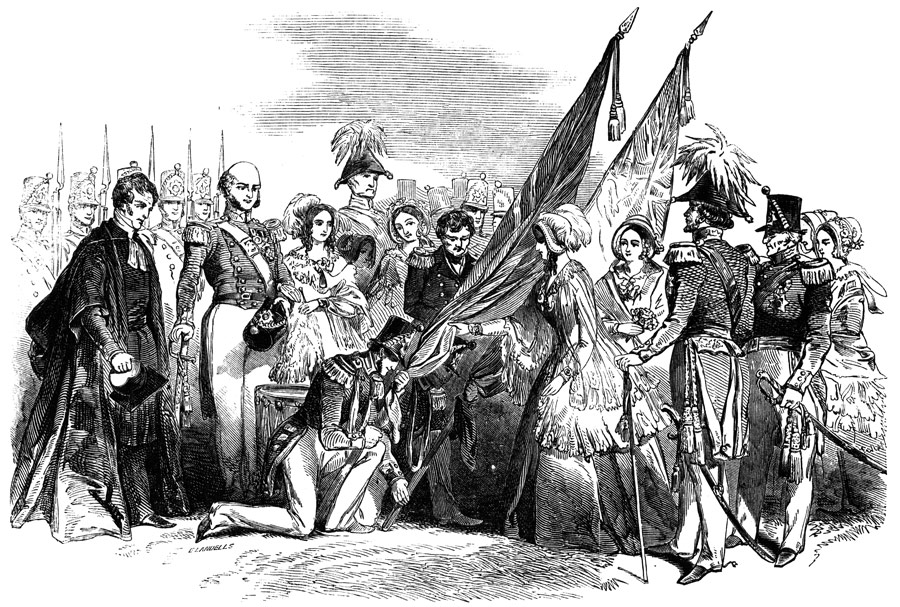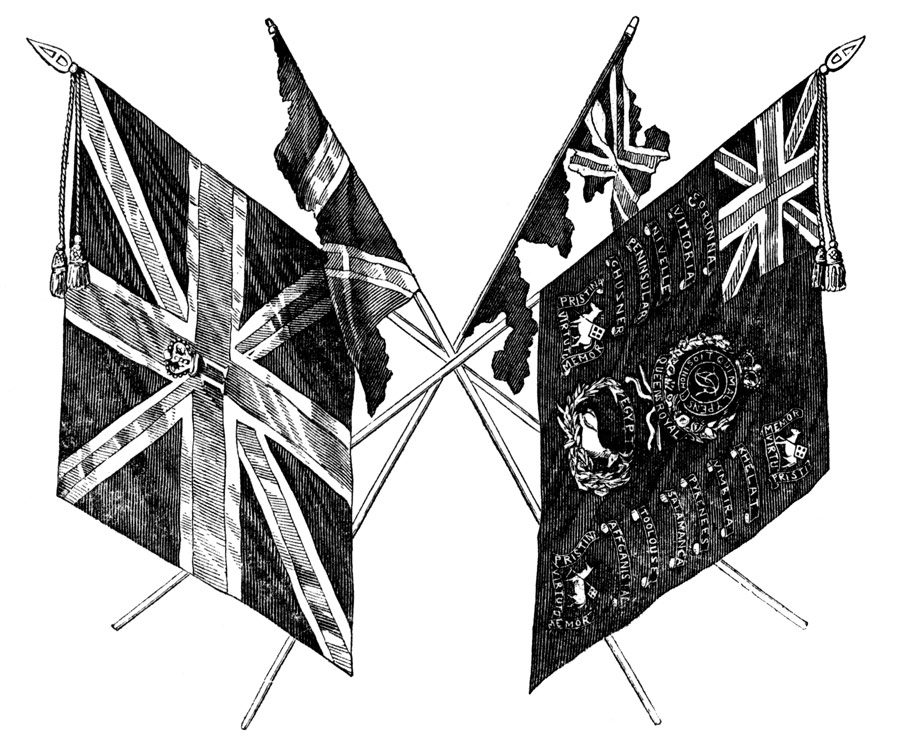The Colours of The Second or Queen’s Royal Regiment
The Hundred Year Colours
During the campaign in Afghanistan in 1839-1840, the Colours presented to the Regiment in 1820 were reduced to rags. New Colours were therefore presented to the Regiment on its return to England. This presentation took place on Saturday 10th July 1847 at Gosport and was made by Lady Augusta Fitzclarence.
 |
| Figure 12 |
| Presentation of new Colours to The Second (Queen's Royal) Regiment, at Gosport. From The Illustrated London News, July 1847. (Click to enlarge) |
A Royal Warrant had been issued in 1844, which laid down a number of regulations which were followed by the 1847 Colours of The Queen’s. In these regulations, the first Colour was to be called “Royal”; the second Colour was to be called “Regimental”; Colours were to bear a central roundel with Regimental title and number; and finally, distinctions and battle honours were to be placed on the Regimental Colour only.
The 1847 stand of Colours was once again the traditional size of approximately six feet square, which in 1855 was regularised by a Royal Warrant as six feet six inches, and was destined to remain in service for exactly 100 years. This the author believes to be an unique event in the history of the Colours of line regiments. The Colours were of course worn and damaged over the years, but were carefully mended and preserved. These famous Colours, the last to be carried into battle (the practice ceased after the first Boer War) had for some years pride of place in the dining room of the Officers’ Mess of the Depot of the Queen’s Division, to which they were presented by the Regiment in 1968. On the closure of this depot, the Colours were returned to the Regiment and currently they are displayed at Clandon Park.
The Queen’s Colour consisted of the Union, with a Roman II surmounted by a royal crown in the centre. After the Great War, the following battle honours were selected from those awarded to the Regiment to be borne on the lateral arms of St George’s cross:
RETREAT FROM MONS |
SOMME 1916 ’18 |
YPRES 1914 ’17 ’18 |
MESSINES 1917 |
VITTORIO VENETO |
GALLIPOLI 1915 |
MACEDONIA 1916-17 |
PALESTINE 1917-18 |
MESOPOTAMIA 1915-18 |
NW FRONTIER INDIA 1916 '17 |
The Regimental Colour underwent a considerable number of changes over the years to take account of battle honours awarded. In 1847, the Colour was a blue sheet with the Union in the first canton. In the centre of the Union was a Roman II, and at each of the other three corners was a paschal lamb, still with a swallow-tailed flag, above the motto “Pristinae Virtutis Memor”. At a later stage, a fourth paschal lamb appeared in the centre of the Union, the Roman II moving to a position above this lamb. In the centre of the Colour was the Garter surmounted by a royal crown and surrounded by the union wreath. In the centre of the Garter, Queen Victoria’s cypher – VR – replaced that of Queen Catherine for the first time since 1661 but in 1902, after the accession of King Edward VII, permission was granted for the cipher to revert to the original interwoven C pattern, (for details see the section on the 4th Battalion) which remained in use thereafter.
Below the Garter was a scroll bearing the title QUEEN’S ROYAL and below this a second longer scroll bearing the motto “Vel Exuviae Triumphant”. This is the first appearance of this motto, which is usually translated as “Triumphant even in adversity”. Beneath this motto was the Sphinx.
Initially, the battle honours borne on the Regimental Colour were:
VIMIERA |
CORUNNA |
SALAMANCA |
VITTORIA |
PYRENEES |
NIVELLE |
TOULOUSE |
PENINSULAR |
AFFGHANISTAN 1839 |
GHUZNEE |
KHELAT |
|
As a result of the First South African War, the battle honour SOUTH AFRICA 1851.2.3 appeared below the Sphinx. Later, after the China campaign of 1860, the battle honours PEKIN and TAKU FORTS were added to left and right of the Sphinx, as shown in figure 13.
 |
| Figure 13 (Click to enlarge) |
A major alteration in the Colour’s appearance came about as a result of honours awarded between 1902 and 1912. These included not only honours for the campaigns in India and South Africa at the turn of the century, but also distinctions awarded in retrospect: TANGIER 1662-80, the oldest battle honour of the Army awarded only to The Queen’s and the Royal Dragoons; NAMUR 1695; and the Naval Crown superscribed 1 JUNE 1794. The final addition came after the Great War – the distinction AFGHANISTAN 1919.
During 1931, the Army Council canvassed the views of all infantry regiments, as it was considered that battalion numerals or regimental titles on the King’s Colour should be transferred to the first canton from the centre of the Colour and replaced by the royal cipher. The replies from Commanding Officers of battalions of The Queen’s reflect the wide variation of patterns in service throughout the Regiment; as a result of a lack of unanimity across the infantry, the Army Council took no action, although further standardisation was achieved later – not least as Colours began to be replaced at much shorter intervals.
The Colours were repaired with great difficulty by Messrs Hobson and Sons in 1937 – 38 in order to make them last 100 years; also of great significance is the fact that, in recognition of the service of the 22nd and 24th London, the battle honour MACEDONIA, 1916-17 replaced HINDENBURG LINE on the King’s Colours of all battalions of the Regiment by the authority of Army Order 150 of 1939. An examination of the 1847 King’s Colour reveals, however, that this change was not effected until after these Colours were replaced.
What is surprising about the retrospective honours (and this is not confined to The Queen’s) is the many omissions. No awards, for example, for service in Spain during the War of the Spanish Succession despite the fact that the Regiment fought with great distinction. Also no awards for service at the same period in the Low Countries under Marlborough in what was one of the Army’s greatest periods.
By 1920 the Sphinx had been moved to below right of the Garter, balanced by the Naval Crown below left of the Garter. The battle honour scrolls were aligned in two columns down the left and right sides of the Colour, thus:
TANGIER 1662-1680 |
NAMUR 1695 |
VIMIERA |
CORUNNA |
SALAMANCA |
VITTORIA |
PYRENEES |
NIVELLE |
TOULOUSE |
PENINSULAR |
GHUZNEE 1839 |
KHELAT |
AFFGHANISTAN 1839 |
SOUTH AFRICA 1851.2.3 |
TAKU FORTS |
PEKIN 1860 |
BURMA 1885-87 |
TIRAH |
RELIEF OF LADYSMITH |
SOUTH AFRICA 1899-1902 |
AFGHANISTAN 1919 |
|
In this form, the Colours remained in service until they were laid up in 1947. No doubt many former members of 1st Queen’s will remember them, most of all the luckless ensigns who had to struggle through parades carrying them – a feat which in windy weather required the use of both hands and a great deal of physical effort.
The writer understands that it became the custom to place a silver tally on the Colour pikes recording the name and occasion of each ensign carrying the Colours, and that these tallies became a considerable hazard to the hands! It is further believed that the pikes were of some antiquity at the time of the presentation of these Colours and may have been nearly 200 years old by the time the Colours were removed from service.
Presentation of New Colours to The Second, (Queen's Royal) Regiment, at Gosport.
The Illustrated London News, 17th July 1874
Old and New Colours
(Click to enlarge)
On Saturday afternoon, this distinguished regiment., commanded by Lieutenant-Colonel Carruthers, C.B., quartered at Forton, near Gosport, was presented with new Colours, by Lady Augusta Fitzclarence and Miss Fitzclarence, the wife and daughter of Major General the Right Hon. Lord Frederick Fitzclarence, G.C.H., Lieutenant-Governor and Commander-in-Chief of the district. Preparatory to the ceremony, at half-past one, the Regiment formed in line to receive the General, who arrived at the hour appointed, accompanied by Lieutenant General Lord Saltoun, K.C.B., G.C.H., &c., Colonel of the 2nd, the staff, and the Ladies Fitzclarence. The Regiment then formed square, and the Colours were brought into the centre and placed upon the big drum head. The Rev. Henry Aubrey Veck, M.A., incumbent of St. John's, Forton, and chaplain to her Majesty's troop in Forton and Haslar Barracks. Lady Augusta Fitzclarence then received the Queen's Colour from the Senior Major (Gilland), and presenting it to the Colonel, Lord Saltoun, addressed him as follows:— "I feel exceedingly happy in being selected to present this Colour to your gallant Regiment, and I feel quite satisfied it cannot be given into better hands. I feel extreme pleasure in giving this Colour to you, Lord Saltoun, being one of my earliest and oldest friends." Lord Saltoun having acknowledged the compliment paid to himself and the Regiment, The Hon. Miss Fitzclarence presented the Regimental Colour to Major Lloyd. They were next consigned to the custody of Ensigns M'Carthy and Inglis the Senior Ensigns. The Grenadiers then closed ranks, and wheeling to their left, proceeded to the centre, where they joined the Ensigns bearing the Colours, and trooped them in the usual form, concluding by the escort of the old Colours to the Orderly Room, the band playing "Auld lang syne." The line then wheeled back into open column right in front, and marched past the Generals in slow and quick time, Lord Saltoun (their Colonel) receiving the salute. After which, both Generals, accompanied by their Staffs, inspected the Regiment in column, and bestowed on them the highest commendation. After the ceremony, a superb déjeúner was served to 200 guests, in a tent on the parade; the company, including Sir Charles Ogle (the Naval Commander-in-Chief), Rear-Admiral Hyde Parker, and their respective circles. |
Related

